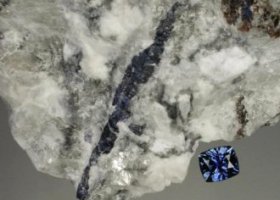August Editorial

Credit: B.S. Wilson
August Editorial Credit: B.S. Wilson
Canadian Sapphire |
|
Finding gemstones of any kind is a job for those with a real passion for it, since the success rate is somewhat discouraging. This is certainly true for those looking for sapphires in Canada. In the whole vast country, so far there is only one place where significant deposits of gem quality sapphires have been found. As one geologist puts it: 'Finding sapphires in Canada is like finding a sparkly needle in a tundra haystack'. |
|
|
The Canadian sapphire deposits were only discovered in 2002. They are in the north near Kimmirut, on southern Baffin Island, Nunavut. However if your country has to have to have just one area of sapphire deposits, those on Baffin Island are certainly the ones to have. In one deposit, the Beluga pit, sapphires are typically elongate barrel-shaped crystals tapered at each end. The size range is up to 7.7 × 2.1 cm, although most sapphires are smaller. The majority of crystals are colour-zoned, displaying concentric and irregular variations in colour, ranging from colourless through shades of dark to light blue. What makes this deposit particularly impressive is not only the quantity of the sapphires but also their quality. Beluga sapphires are of such good quality that they don't have to be heated to intensify their colour and clarity. This is unlike almost 99% of sapphire gems which have to be heat-treated to enhance their appearance. The abundance of the gems and their quality prompted researchers from the University of British Columbia to look closely at the geological events which lead to the formation of sapphire at this location. Their study (published in 'Canadian Mineralogist' (ref) ) showed that three major metamorphic events produced the sapphires in these deposits. All were of equal importance. The first event was the formation of nepheline, diopside, and K-feldspar. Nepheline is a feldspathoid, i.e. it belongs to a group of tectosilicate minerals which resemble feldspars but have a different structure and much lower silica content. Those rocks are sensitive to weathering and degradation under the right conditions. For example, Nepheline is susceptible to weathering and can be easily decomposed by HCl. Exposure to hydrochloric acid results in the separation of silica and cubes of salt. That brings us to the second event which happened at around 1782.5 ± 3.7 Ma (1 Ma = one million years) when an influx of fluid bearing CO2-, H2O-, Cl-, F- caused the partial degradation of the original minerals to form phlogopite, oligoclase, calcite, and scapolite. Finally, the third major tectonic event caused regional retrograde metamorphism resulting in the breakdown of scapolite + nepheline to form albite, muscovite, corundum (sapphire being the blue coloured corundum), and calcite. Phil Belley, the main author of the recent publication (see ref) believes that their model for the formation of sapphires on Baffin Island can be used to find sapphires elsewhere in the world: "Look at the metamorphic history of the area, and if it's suitable for that type of deposit, it's worth looking for the indicator minerals." he suggests In his case one of those indicator minerals was scapolite. In Kimmirut this is extremely fluorescent, glowing an intense bright yellow colour when exposed to long-wave ultraviolet light. Scapolite has an appearance that is very similar to many feldspars. As a result, it can easily be overlooked in the field and during hand specimen examination in a laboratory. This mineral is found in regionally metamorphosed rocks such as marble, gneiss, and schist. In metamorphosed igneous rocks, scapolite often occurs as complete or partial replacements of the feldspar grains. Scapolite minerals are easily attacked by weathering. They are some of the first minerals to be affected by it. As weathering begins, the mineral grains lose their transparency, become opaque, and have a reduced hardness. The current studies also showed that the corundum-forming reaction only occurs in a < 100oC window with an upper limit determined by scapolite-nepheline stability, and a lower limit determined by the formation of Al-silicate rather than corundum. To test the model, Belley also took samples from a location in New York state where scapolite with the same fluorescence feature is present. And indeed he found pink sapphires. Unfortunately finding a location where sapphires might be present does not guarantee that the stones will be gem quality. Sadly those found at the New York location were not. Journal Reference: | |
| _______________________________ | ||||
| Home | | | Shopping | | | Database |
© Biscuit Software 2004-2017
All rights reserved